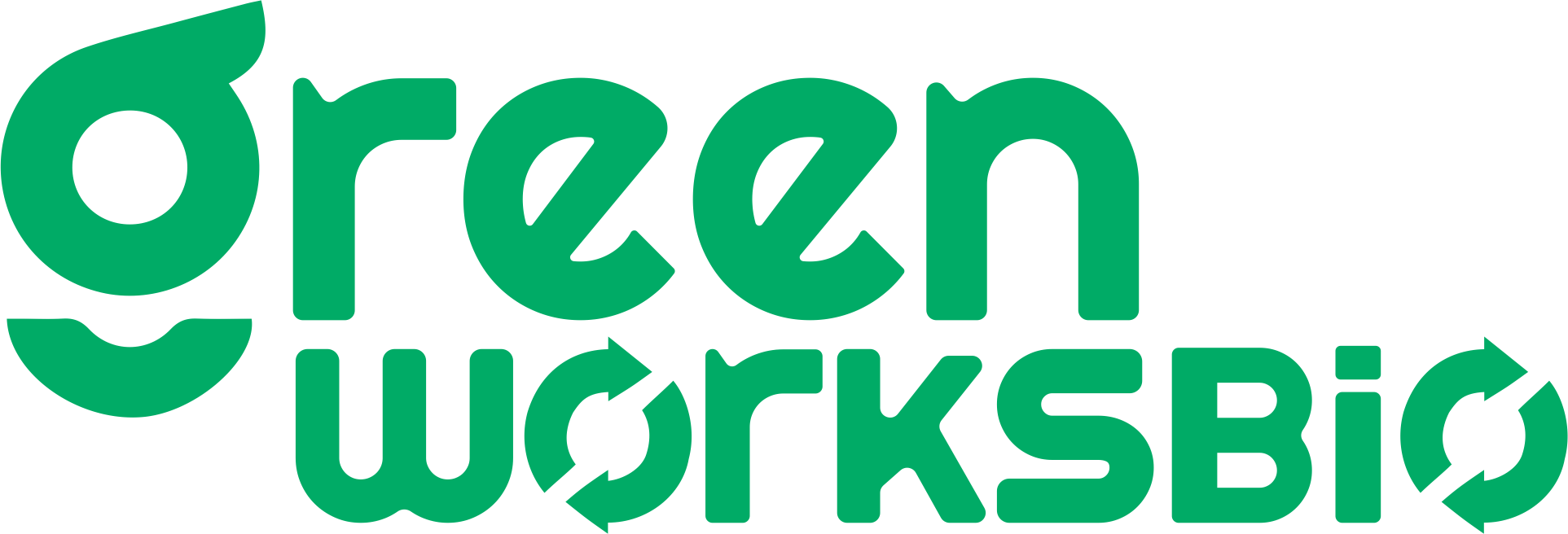| TLDR Single-use plastic is a major polluter—cheap, convenient, but harmful to ecosystems, with most of it derived from fossil fuels and used only once. Global bans and consumer pushback are making plastic-heavy packaging risky for brands. Ten proven alternatives to single-use plastic include compostable bioplastics, bagasse tableware, recycled paper, molded fiber, and mushroom packaging. Greenworksbio offers certified alternatives (PLA+PBAT blends, custom-sized compostables) tailored for India’s waste systems and supply chains. Certifications matter—CPCB, EN 13432, ASTM D6400 ensure compliance, credibility, and easier regulation adherence. Transition smoothly: Map your plastic usage, match alternatives to functional needs, and verify materials before switching. Eco-friendly doesn’t mean complicated—sustainable options are scalable, practical, and customer-approved. |
|---|
Single-use plastic products are cheap, convenient, and everywhere, but they’re also choking our ecosystems, polluting supply chains, and facing increasing bans across the globe.
From disposable cutlery and grocery bags to PET bottles and cling films, single-use plastics account for more than a third of all plastic produced, and 98% of it comes from fossil fuels. According to a 2023 report by the UNEP, global plastic production is projected to triple by 2060 if left unchecked, with the majority of this growth attributed to single-use packaging.
But here’s the good news: viable, affordable, and compostable options are already being used by forward-thinking brands, and eco-friendly alternatives to single use plastic are more accessible than ever.
If you’re looking to reduce your plastic footprint without compromising on performance or scale, here are 10 proven eco friendly alternatives to single use plastic that offer compliance, customer trust, and operational flexibility.
What Are Single-Use Plastics And Why Replace Them Now?
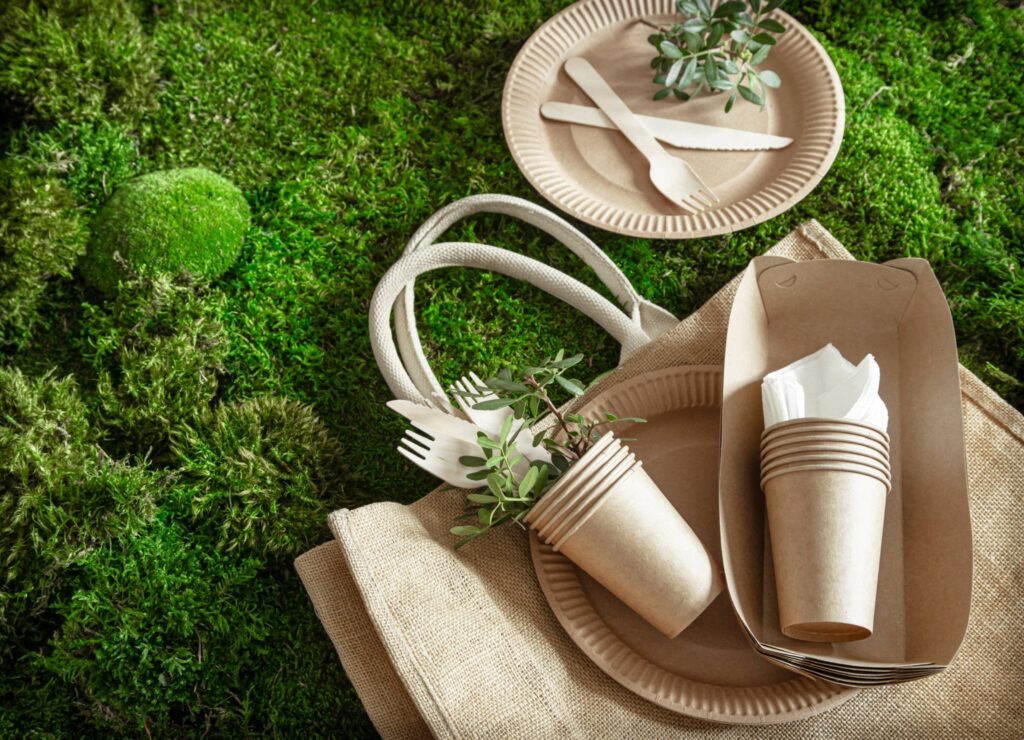
Single-use plastics, including plastic straws, are items designed to be used once and discarded. They include bags, wrappers, bottles, cups, and packaging layers found in nearly every product category.
Why they’re a problem:
- Non-biodegradable: Most take over 400 years to decompose when it comes to single-use plastics, unlike reusable bottles.
- Wasteful: Often used for minutes, yet persist in landfills and oceans for centuries.
- Regulated: More than 170 countries have pledged to curb or ban single-use plastics.
- Consumer backlash: Eco-conscious buyers are increasingly ditching plastic-heavy brands.
Replacing single-use plastics isn’t just a trend, it’s becoming a regulatory and reputational necessity. Brands that act early are better positioned to meet Extended Producer Responsibility (EPR) mandates, win procurement bids, and future-proof their operations.
What are the 10 Scalable Alternatives to Single-Use Plastic?
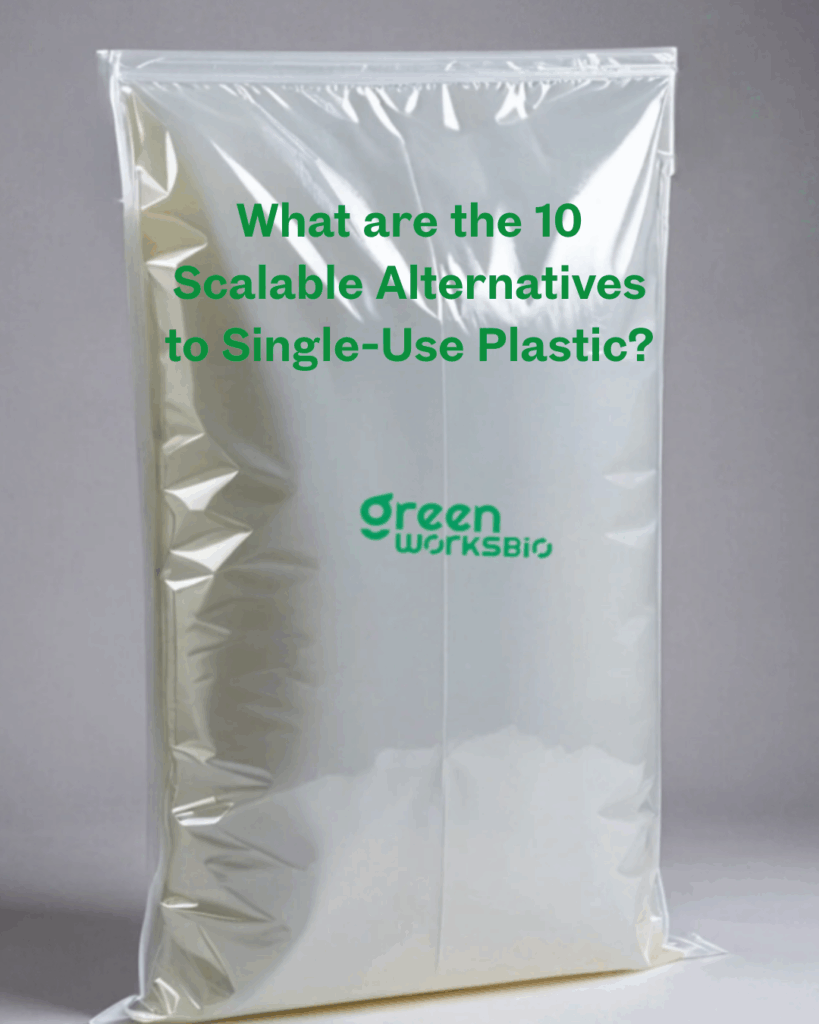
Whether you’re building a zero-waste supply chain or just starting to explore green packaging, these ten alternatives to single use plastic can help you shift to more sustainable materials without reinventing your entire product line.
1. Compostable Bioplastics (PLA + PBAT Blends)
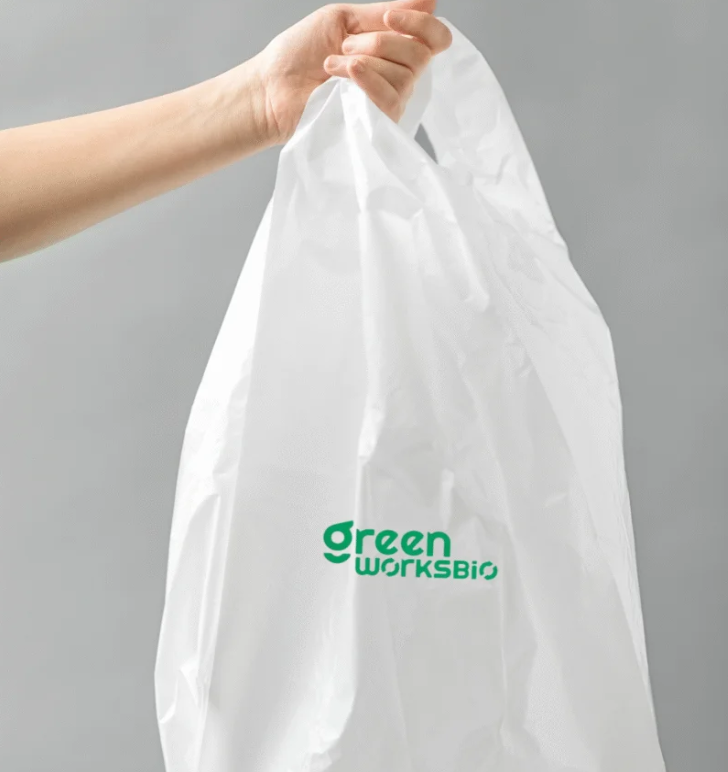
Bioplastics made from natural materials like corn starch or sugarcane are used to create eco-friendly alternatives to plastic using raw materials. A common example is a blend of PLA (polylactic acid) and PBAT (polybutylene adipate terephthalate).
This blend looks and works like regular plastic—it’s strong and flexible—but unlike plastic, it breaks down naturally in 3 to 6 months when processed in an industrial composting facility.
Where it’s used:
These materials are great for making grocery bags, spoons and forks, water bottles, courier packaging, and food trays.
Certifications to check for:
- CPCB (India) – For compliance with Indian composting standards
- EN 13432 and ASTM D6400 – Global compostability standards
- TÜV Austria – Trusted certification for industrial/home composting
Greenworksbio offers CPCB-certified products, compostable alternatives to single-use plastic—durable, scalable, and built for India’s waste systems. All products come with customizable size, thickness, and weight-bearing options to suit diverse packaging needs.
2. Biodegradable polymers and bio-based and recycled plastics
Biodegradable polymers, bio-based plastics, and recycled plastics are scalable alternatives for industries needing to phase out single-use plastics. These products originate from renewable resources and offer lower carbon footprints.
| Material Type | Key Benefits |
|---|---|
| Biodegradable polymers | Break down naturally in controlled environments |
| Bio-based plastics | Reduced reliance on petroleum-based plastics |
| Recycled plastics | Promotes circular material reuse |
These materials present a sustainable solution to plastic production, ensuring businesses can achieve their eco-goals while maintaining product performance. By adopting these options, companies actively contribute to reducing landfill waste and advancing global sustainability goals.
3. Molded Fiber Containers and Lids
Blends like PLA (polylactic acid) and PBAT (polybutylene adipate terephthalate) are plant-based alternatives that resemble regular plastic in appearance and performance yet break down within 90–180 days in industrial composting.
These bioplastics are strong, flexible, and suitable for both hot and cold items. They’re widely used for:
- Grocery and courier bags
- Cutlery, trays, and bowls
- Water bottles (non-chemical use)
What sets them apart is that they don’t leave toxic residue, making them safer for soil and waste systems. However, they require proper composting facilities to break down entirely.
4. Sugarcane Bagasse-Based Tableware
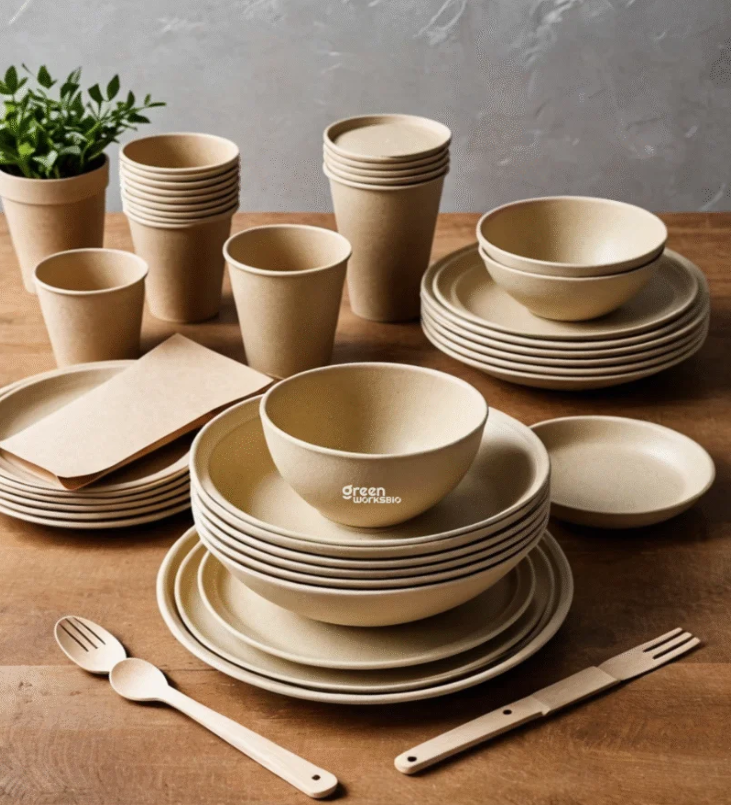
Bagasse is a natural byproduct that comes from crushing sugarcane to extract juice. Instead of throwing it away or burning it, manufacturers use this leftover fibrous pulp to make eco-friendly tableware.
What makes bagasse special is its heat resistance, durability, and compostability. It can handle hot, wet, or oily food without leaking or collapsing, just like plastic or foam plates. However, unlike polystyrene or plastic-coated paper, it breaks down easily in composting conditions, making it a more environmentally friendly option.
Because of its strength and safe use with food, bagasse is widely used to make:
- Plates, bowls, and trays for serving meals
- Clamshell containers for takeout orders
- Compartment trays for buffets or hospital meals
Bagasse-based products are a cost-effective and scalable solution for replacing single-use plastics—especially in food-related businesses that serve large crowds and require durable yet sustainable packaging options.
5. Recycled Paper and Cardboard Packaging
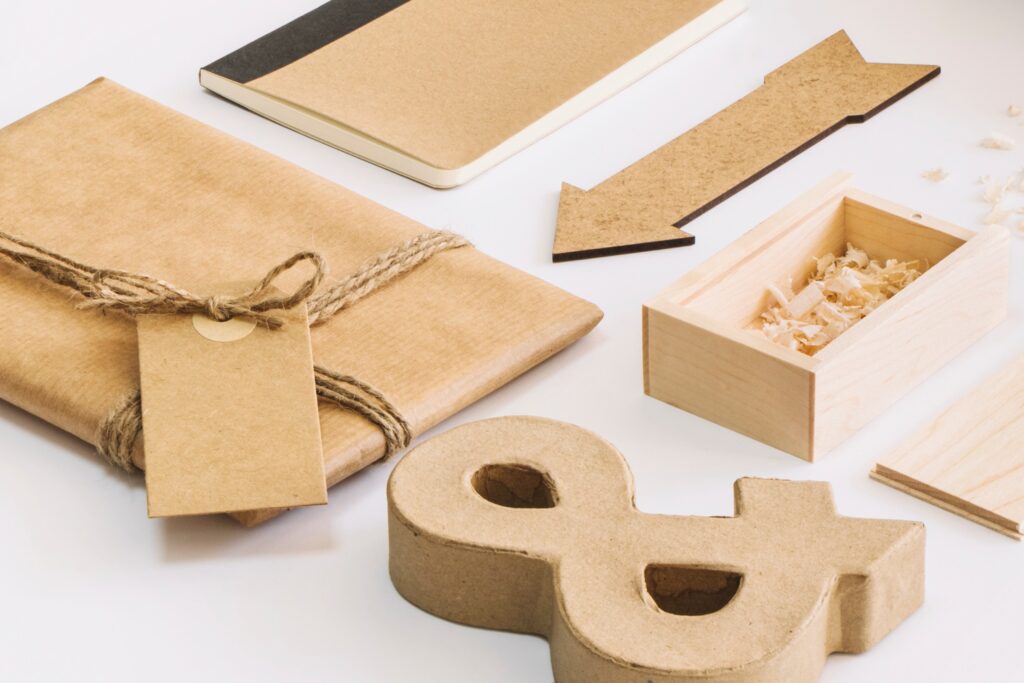
Recycled paper and cardboard are popular plastic alternatives made from post-consumer waste like old newspapers and boxes. Labels like “FSC-certified” show the materials come from responsible or recycled sources, helping reduce landfill waste and the need for virgin paper.
Recycled paper and kraft board are strong, lightweight, and highly customizable. They can be used for:
- Outer shipping boxes (instead of plastic mailers)
- Product cartons and sleeves
- Protective inserts inside boxes
- Labels and packaging fillers
These materials are especially good for eCommerce packaging, retail display boxes, or any product that needs structure and branding. Unlike plastic, they are widely accepted in curbside recycling programs, making it easy for customers to dispose of them responsibly.
6. Corrugated bubble wrap
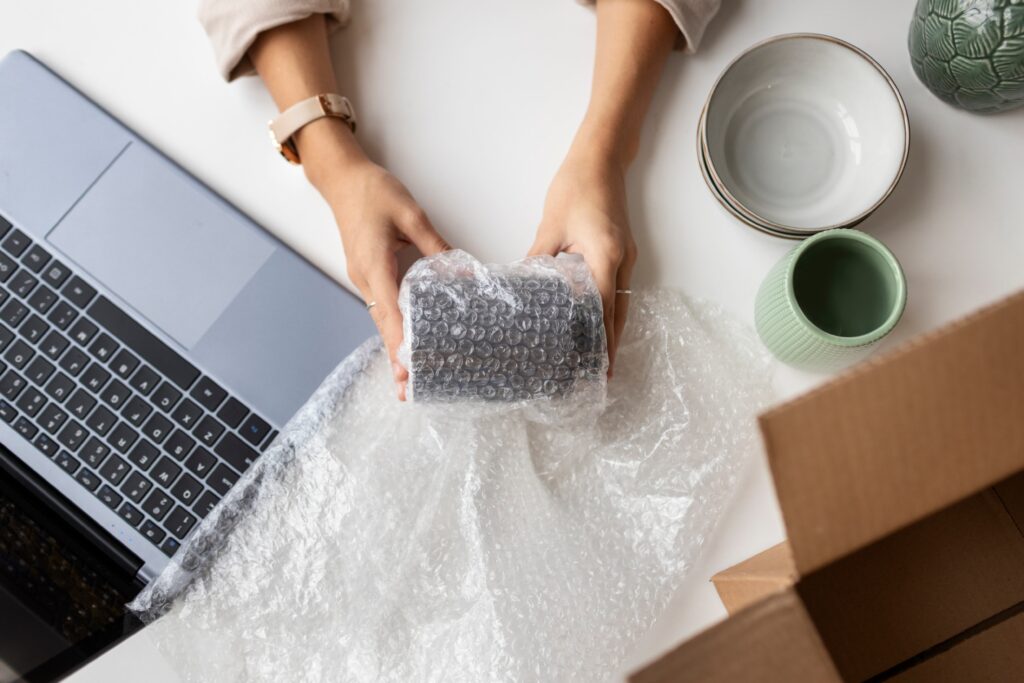
Corrugated bubble wrap is a smart alternative to plastic bubble wrap, made entirely from recycled paper. It offers the same protective cushioning but is biodegradable and compostable, making it a more sustainable choice for shipping and packaging.
This eco-friendly wrap helps reduce plastic waste, lowers carbon emissions from packaging, and supports responsible shipping practices by cutting down on single use plastics. It’s ideal for eCommerce, fragile goods, and brands looking to align with sustainability goals, without compromising on protection.
7. Organic fabrics
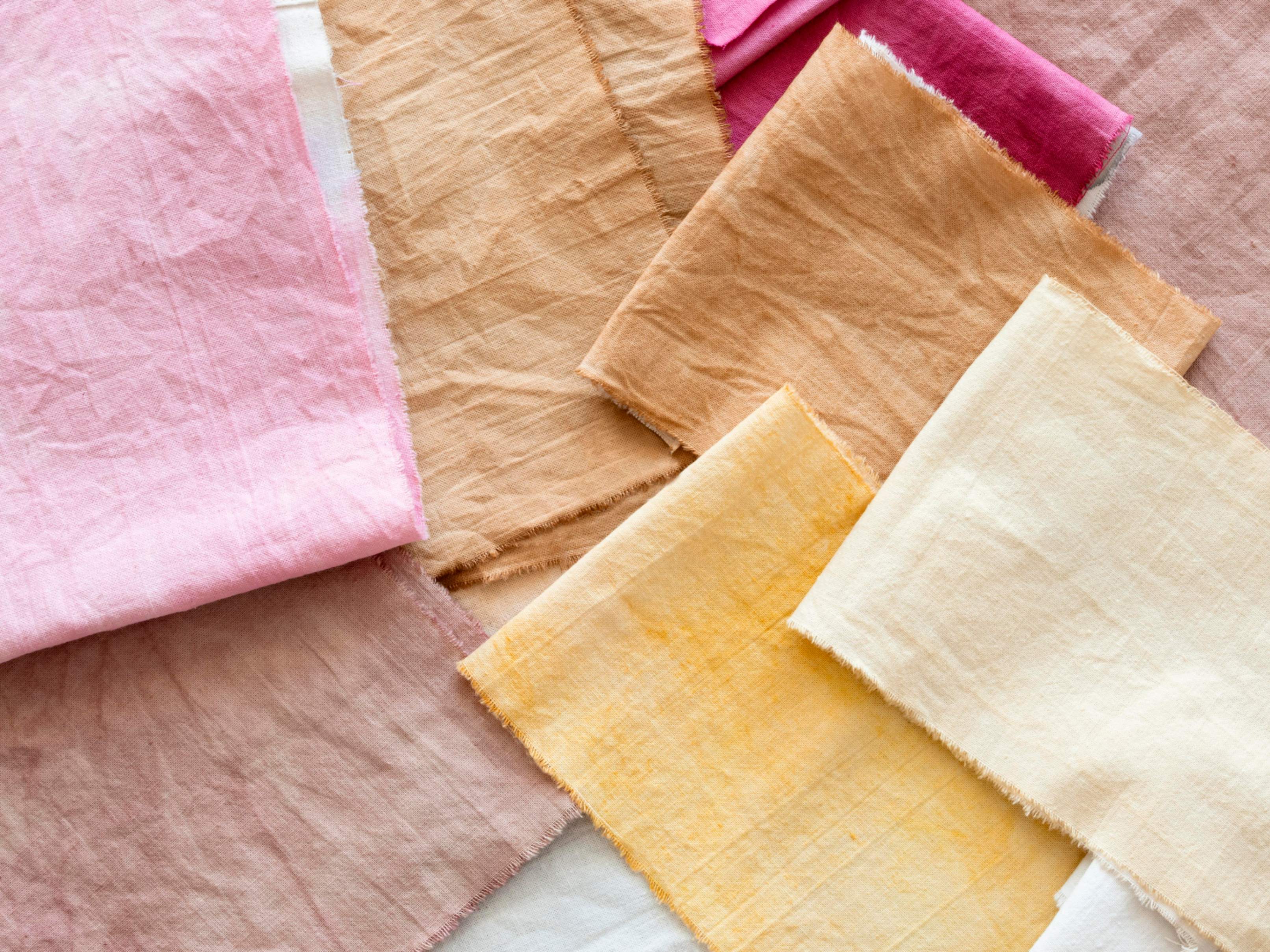
Organic fabrics made from natural fibres like cotton, hemp, and bamboo offer a reliable alternative to synthetic, plastic-based textiles. Unlike polyester or nylon, these materials are biodegradable, reduce reliance on fossil fuels, and have a lower carbon footprint.
Their production typically involves eco-friendly farming methods, which avoid synthetic pesticides and chemicals, benefiting both ecosystems and farmer health. As sustainability becomes a key factor in consumer decisions, organic fabrics are gaining popularity across the fashion, packaging, and lifestyle sectors.
Choosing them supports a cleaner supply chain while replacing plastic at the fibre level.
8. Aluminum and Glass
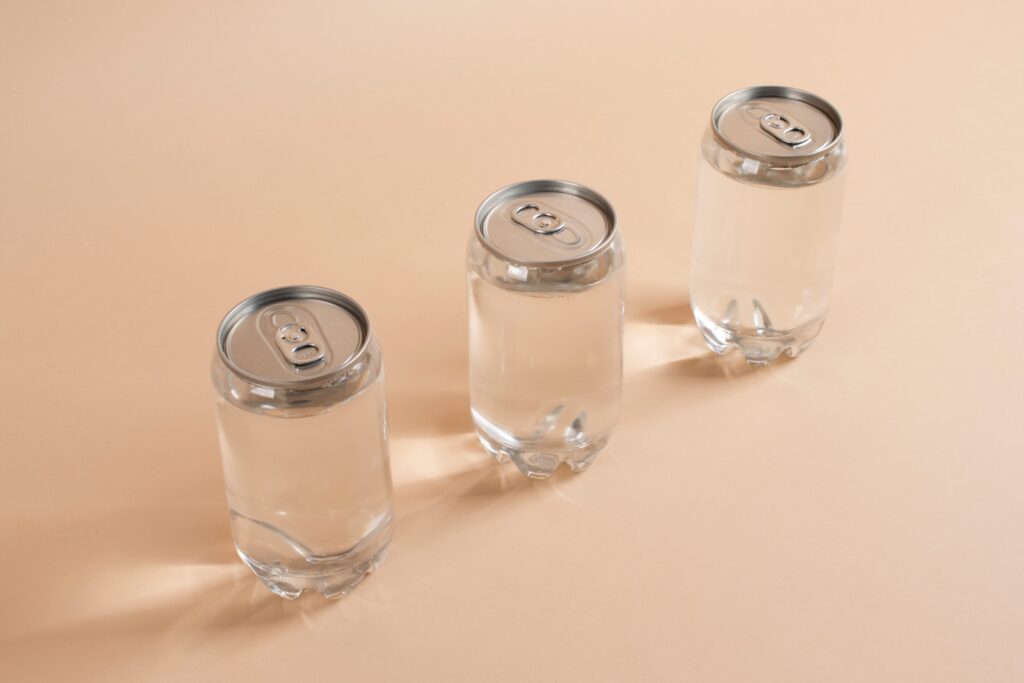
In cases where compostable packaging isn’t ideal—such as for products with long shelf lives, acidic foods, or liquids requiring a strong barrier—materials like aluminium and glass become the more practical choice. These formats offer superior protection and excellent shelf stability and can be reused or recycled without losing quality.
Aluminium, in particular, is infinitely recyclable, lightweight, and highly resistant to moisture and oxygen, making it suitable for RTD (ready-to-drink) beverages, aerosols, and cosmetics. Glass, on the other hand, offers a premium look, is chemically inert, and is ideal for use in sauces, skin care products, or pharmaceutical packaging.
Both materials support closed-loop recycling, making them effective alternatives to plastic where compostables may fail to meet durability, safety, or regulatory needs.
9. Mushroom packaging
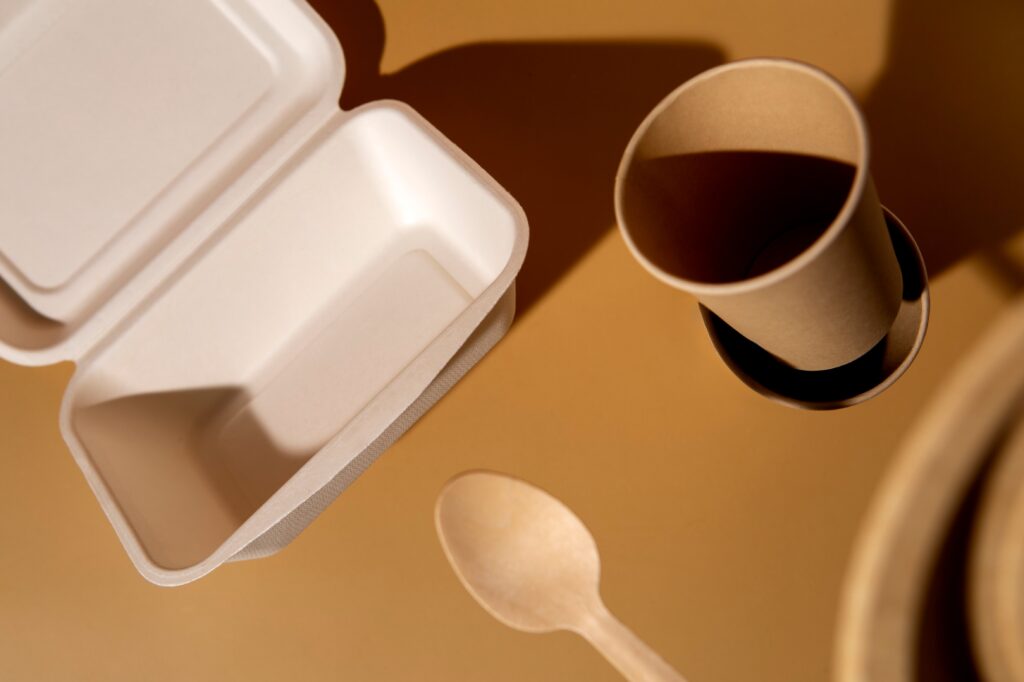
Mushroom packaging is a cutting-edge, biodegradable solution made from mycelium—the root structure of fungi—grown around agricultural waste, such as corn husks or hemp stalks and other natural resources. Once dried, it forms a lightweight, foam-like material that can be moulded into custom shapes, offering both protection and sustainability.
Because it’s made from waste materials and fungi, mushroom packaging supports a circular economy, transforming agricultural byproducts into valuable products and eliminating the need for virgin plastic or synthetic fillers.
It’s gaining traction among environmentally conscious brands for its low energy production, home compostability, and zero-waste credentials. As global interest in regenerative packaging grows, mushroom packaging stands out as a functional, scalable, and soil-positive alternative to single-use plastics.
10. Seaweed packaging
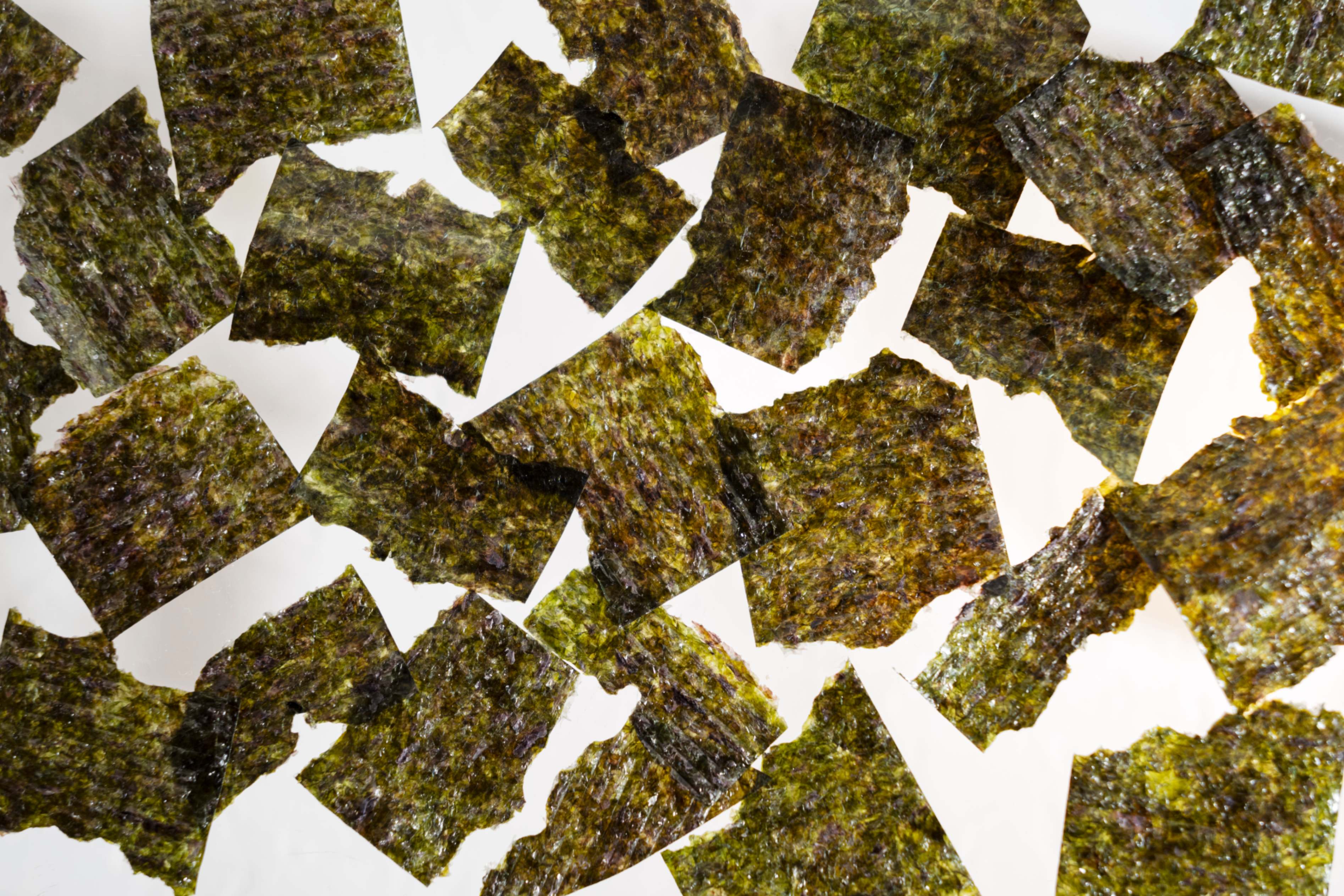
Seaweed packaging offers a natural, biodegradable alternative for items like food wraps, straws, and drink sachets. Made from edible compounds extracted from ocean plants, it serves as edible packaging that safely breaks down without harming the environment, especially marine ecosystems.
By replacing single-use plastics with seaweed-based materials, brands not only reduce pollution but also support ocean health. This innovation also allows businesses to showcase their commitment to sustainability, appealing to eco-conscious consumers seeking planet-friendly choices.
How to Transition Away from Single-Use Plastic Without Disrupting Operations?
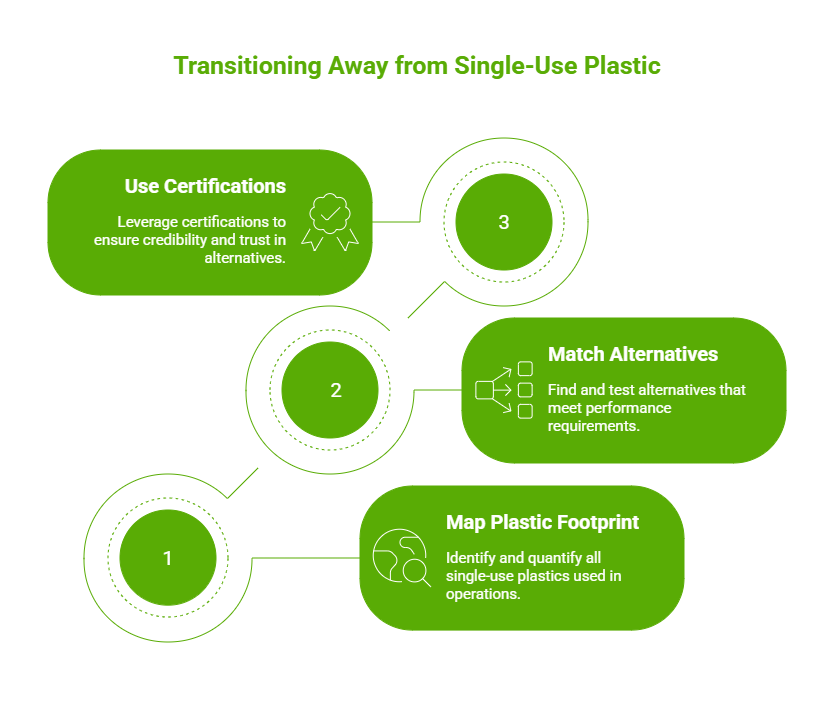
Shifting away from single-use plastics doesn’t have to mean reworking your entire supply chain. With the right strategy, businesses can adopt alternatives for single use plastic while keeping operations smooth and cost-efficient.
Here are three actionable steps to make the transition effective—without compromising on performance, compliance, or customer expectations.
Step 1: Map Your Plastic Footprint
Start by identifying where and how plastic is used across your operations—from product packaging to shipping and storage. Quantify your usage, track major sources of single-use plastic waste, and highlight high-volume items like bottles, liners, or wrappers.
This mapping exercise helps you spot inefficiencies, set reduction goals, and make data-backed decisions about which materials to phase out or replace first.
Step 2: Match Alternatives to Performance Needs
Switching to sustainable packaging only works if the materials meet your functional needs. Choose alternatives that align with durability, barrier strength, temperature resistance, or storage requirements.
Prioritize:
- Certified materials like PLA+PBAT blends or molded fiber that meet EN 13432 or CPCB guidelines.
- Tailored formats for your industry—like compostable trays for foodservice or recycled paperboard for retail, and shampoo bars for eco-friendly personal care.
- Consumer-aligned choices like bamboo, bagasse, or paper for eco-conscious product lines.
- Reusable or compostable solutions for items with longer shelf lives.
Matching performance ensures a seamless switch, avoiding quality or logistics issues down the line.
Step 3: Use Certifications as a Trust Anchor
Certifications are critical to validating your sustainability claims. Labels like CPCB (India), EN 13432, ASTM D6400, and TÜV Austria show that your materials meet global environmental standards.
They also make it easier to comply with EPR norms, plastic ban regulations, and global frameworks like the Global Plastics Treaty. For customers, certifications reinforce trust and help position your brand as genuinely eco-forward—not just greenwashing.
In short, verified materials give your packaging credibility, simplify regulatory compliance, and build long-term goodwill.
Switch to Certified Alternatives—No Supply Chain Disruption
Making the shift from single-use plastic doesn’t have to slow you down. At Greenworksbio, we offer certified compostable alternatives—like PLA+PBAT blends, molded fiber tableware, and starch-based films—engineered to match your product, logistics, and compliance needs.
Our solutions are designed for real-world performance, backed by CPCB, EN 13432, and ISO 17088 certifications, and customized for strength, shelf life, and cold/hot storage. Whether you’re in foodservice, hospitality, healthcare, or quick-service retail, Greenworksbio ensures your packaging transition is smooth, scalable, and fully compliant, without disrupting your operations.
Go plastic-free without compromise. Contact us today to help you build packaging that works for your brand and the planet.
Conclusion
Transitioning away from single-use plastic packaging is not only essential for environmental sustainability but also offers a range of innovative alternatives that can be scaled for various applications. From compostable bioplastics to mushroom packaging, the options available today provide practical solutions that align with eco-conscious goals.
By carefully mapping your plastic footprint and selecting alternatives of single use plastic that meet performance needs, you can significantly reduce your environmental impact without disrupting your operations. It’s time to embrace these alternatives and contribute to a healthier planet. For personalized advice on making this transition, don’t hesitate to reach out and get a free consultation with our experts!
Frequently Asked Questions
What are the most affordable alternatives to single-use plastic in India?
Greenworks products offer affordable alternatives to single-use plastics in India, including recycled paper packaging, durable cloth bags, and bamboo-based items. These solutions combine cost-effectiveness with sustainability, helping businesses reduce plastic waste without increasing expenses.
What are the best affordable alternatives to single-use plastic available in India?
Affordable alternatives to single-use plastic in India include recycled paper packaging, cloth bags, and bamboo-based products. Recycled paper is cost-effective for food and retail packaging, while bamboo utensils and cloth totes offer durable, reusable options. These solutions help reduce plastic waste without straining your budget, making sustainable choices accessible for businesses and consumers alike.
Can traditional materials like banana leaves be used at scale?
Yes, banana leaves can be scaled as sustainable alternatives for packaging, especially in food-related industries. While their durability may limit applications, they represent a promising option for small- and medium-scale operations prioritizing green practices in their supply chain.
What steps can individuals take to reduce single-use plastic at home?
Start by switching to reusable bags for grocery shopping and using alternatives like beeswax wraps for food storage. Opt for stainless steel containers and glass containers as well as refillable water bottles. These small lifestyle changes help reduce single-use plastic consumption effectively.

